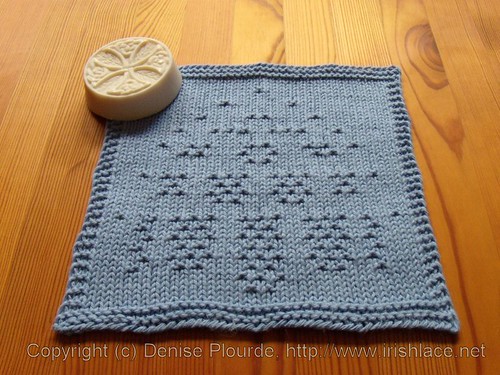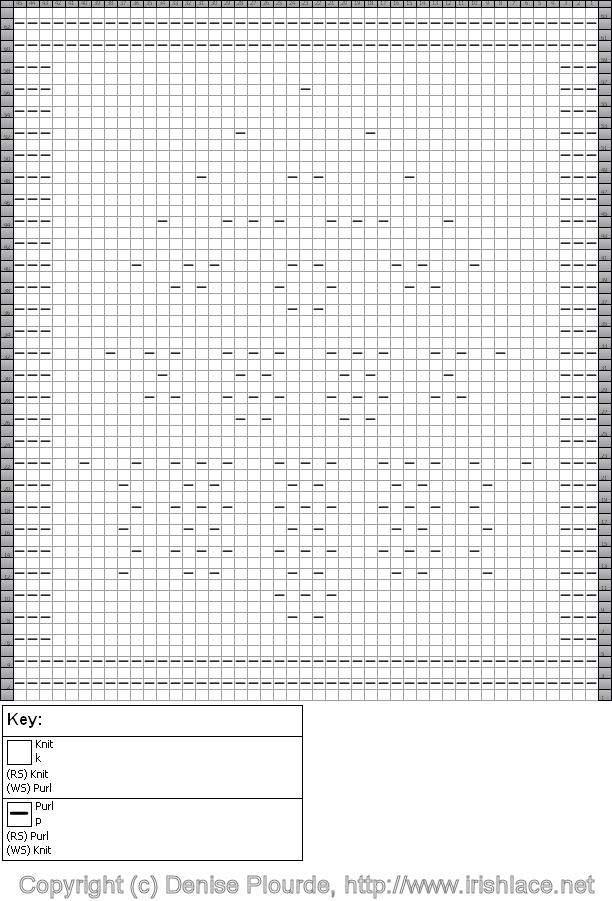An arch based on Pascal's Triangle. Because even nerds need to wash up.
Materials
Worsted weight cotton (sample was made with Lion Cotton, color 183, Periwinkle), about 60 yds per cloth
Needles that give you a gauge of 5 st/in. This is if you want to make a standard 9" cloth. If not, use needles that give you a fabric you like with the yarn you use. (The samples were made using US4/3.5mm.)
Yarn needle for weaving in ends
Optional: Celtic Cross Soap from EclecticLady.com (Also available in clear and glitter.)
Please note:
- The graph includes all rows.
- The pattern is worked on the wrong side rows. The right side rows are all knit across.
- Click the graph image to see a larger view.
Instructions
In pictures
In words
Abbreviations:k: knit
p: purl
Instructions:
Cast on 45 stitches
Rows 1-5: k across
Row 6: k3, p39, k3
Row 7 (and all odd (right side) rows up to 57): k across
Row 8: k3, p18, k1, p1, k1, p18, k3
Row 10: k3, p17, k1, p1, k1, p1, k1, p17, k3
Row 12: k3, p5, k1, p4, k1, p1, k1, p5, k1, p1, k1, p5, k1, p1, k1, p4, k1, p5, k3
Row 14: k3, p6, k1, p2, k1, p1, k1, p1, k1, p3, k1, p1, k1, p1, k1, p3, k1, p1, k1, p1, k1, p2, k1, p6, k3
Row 16: k3, p5, k1, p4, k1, p1, k1, p5, k1, p1, k1, p5, k1, p1, k1, p4, k1, p5, k3
Row 18: k3, p6, k1, p2, k1, p1, k1, p1, k1, p3, k1, p1, k1, p1, k1, p3, k1, p1, k1, p1, k1, p2, k1, p6, k3
Row 20: k3, p5, k1, p4, k1, p1, k1, p5, k1, p1, k1, p5, k1, p1, k1, p4, k1, p5, k3
Row 22: k3, p2, k1, p3, k1, p2, k1, p1, k1, p1, k1, p3, k1, p1, k1, p1, k1, p3, k1, p1, k1, p1, k1, p2, k1, p3, k1, p2, k3
Row 24: k3, p39, k3
Row 26: k3, p14, k1, p1, k1, p5, k1, p1, k1, p14, k3
Row 28: k3, p7, k1, p1, k1, p3, k1, p1, k1, p1, k1, p3, k1, p1, k1, p1, k1, p3, k1, p1, k1, p7, k3
Row 30: k3, p8, k1, p5, k1, p1, k1, p5, k1, p1, k1, p5, k1, p8, k3
Row 32: k3, p4, k1, p2, k1, p1, k1, p3, k1, p1, k1, p1, k1, p3, k1, p1, k1, p1, k1, p3, k1, p1, k1, p2, k1, p4, k3
Row 34: k3, p39, k3
Row 36: k3, p18, k1, p1, k1, p18, k3
Row 38: k3, p9, k1, p1, k1, p5, k1, p3, k1, p5, k1, p1, k1, p9, k3
Row 40: k3, p6, k1, p3, k1, p1, k1, p5, k1, p1, k1, p5, k1, p1, k1, p3, k1, p6, k3
Row 42: k3, p39, k3
Row 44: k3, p8, k1, p4, k1, p1, k1, p1, k1, p3, k1, p1, k1, p1, k1, p4, k1, p8, k3
Row 46: k3, p39, k3
Row 48: k3, p11, k1, p6, k1, p1, k1, p6, k1, p11, k3
Row 50: k3, p39, k3
Row 52: k3, p14, k1, p9, k1, p14, k3
Row 54: k3, p39, k3
Row 56: k3, p19, k1, p19, k3
Row 58: k3, p39, k3
Rows 59-63: k across
Bind off. Weave in ends. Block. Admire. Use.
Explanation
So, wondering what Pascal's triangle is?
You can take the easy way, and go to Wikipedia, but basically, it's a listing of binomial coefficients. In a triangle.
Clear as mud, huh?
Okay, bear with me for a bit... First, you know that anything times one is that thing itself, right? So x is the same as 1x. 1 is the coefficient. Got it? Good.
Let's say you have x + y. Another "anything" rule: anything raised to the zeroth (yes, it's a word) power is one. So (x + y)^0 = 1. The coefficient is 1.
Yet another "anything" rule: anything raised to the first power is the same as the thing itself. So x + y is the same as (x + y)^1. Or, more to the point, (x + y)^1 = x + y. The two coefficients are 1 and 1.
Now, what about (x + y)^2 ? That can be written out as (x + y)(x + y), which can be written as x(x + y) + y(x +y), which can be multiplied to get x^2 + xy + yx + y^2. Since xy and yx are equivalent, they can be added to make 2xy, and the whole thing becomes x^2 + 2xy + y^2. The coefficients are 1, 2, 1.
For (x + y)^3, we have:
(x + y)^3 = (x + y)(x + y)(x + y)
= (x + y)(x^2 + 2xy + y^2)
= x(x^2 + 2xy + y^2) + y(x^2 + 2xy + y^2)
= (x^3 + 2x^2y + xy^2) + (yx^2 + 2xy^2 + y^3)
= x^3 + 3x^2y + 3xy^2 + y^3.
The coefficients are 1, 3, 3, 1.
You can go on and on, and these coefficients will make a pattern: if you arrange them in a triangle with the ^0 coefficient at top, you'll see that the coefficients are the sum of the two coefficients diagonally above them. So for the ^3 example, the middle two numbers were 3 because above them were 1 and 2. 1 + 2 = 3. If you generate the next row, you'll add 3 and 3 to get 6, and that will be below and between the two 3s.
And each row is twice the value of the previous row. So it's related to the binary system, and the sum of all the numbers in row X can be found by using the following formula: 2^X - 1. (In the cloth above, there are 7 rows, and 7 is prime and 2^7-1 equals 127 which is prime, so that's a Mersenne prime. Whee! More mathiness!)
Pascal's triangle is pretty cool, actually, and it's related to Sierpinski's carpet and the Fibonacci sequence, to make it even cooler.
This cloth has clusters of individual purl stitches... Well, actually, they're knit stitches done on the wrong side. But it's okay, because if knit stitches are +1 and purl stitches are -1 on the right side, then the wrong side is the negative of that, and that makes knit stitches on the wrong side -(+1) on the right side, which means... -1. So even though they aren't purls, they look like it.
Ummm... Where were we?
Oh, yes. Purls. Anyway, if you count the purl stitches in each cluster, you'll see that they match up with the pattern of the first seven rows of Pascal's triangle.
1
1 1
1 2 1
1 3 3 1
1 4 6 4 1
1 5 10 10 5 1
1 6 15 20 15 6 1
Wondering why this triangle looks more like an arch?
Simple. I was running out of room.
In a field 40ish stitches wide, there's a limit to how far you can go horizontally. But going vertical means stretching things out to the point where the rows are too far apart for coherence, or where the shape changes. This turned into a fairly close approximation of a gothic arch, and since that's based on circles and equilateral triangles and other good geometric things, I can't complain.

